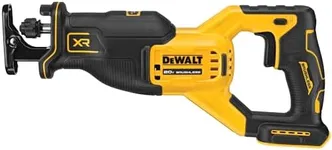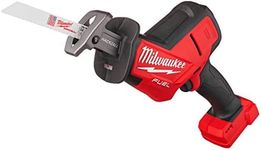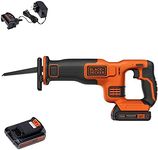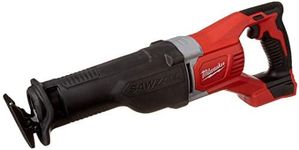Buying Guide for the Best Cordless Reciprocating Saws
Choosing the right cordless reciprocating saw can make a significant difference in your cutting tasks, whether you're a professional contractor or a DIY enthusiast. These versatile tools are used for a variety of applications, including demolition, pruning, and cutting through different materials like wood, metal, and plastic. To find the best fit for your needs, it's important to understand the key specifications and how they impact the performance and usability of the saw.Battery VoltageBattery voltage determines the power output of the saw. Higher voltage typically means more power, which is important for cutting through tougher materials. Common voltages range from 12V to 60V. For light-duty tasks like pruning or cutting thin materials, a 12V to 18V saw may suffice. For more demanding tasks such as demolition or cutting thick metal, a 36V to 60V saw would be more appropriate. Consider the types of materials you'll be cutting and choose a voltage that matches your needs.
Stroke LengthStroke length refers to the distance the blade travels in one complete movement. It affects the cutting speed and efficiency. Common stroke lengths range from 1/2 inch to 1-1/4 inches. A longer stroke length can cut through materials faster and is better for heavy-duty tasks. For general-purpose use, a stroke length of around 1 inch is a good balance. If you need to make precise cuts or work in tight spaces, a shorter stroke length might be more suitable.
Strokes Per Minute (SPM)Strokes per minute (SPM) measures how many times the blade moves back and forth in a minute. Higher SPM means faster cutting speed. Typical SPM ranges from 2,500 to 3,000. For quick and aggressive cutting, a higher SPM is beneficial. However, for more controlled and precise cuts, a lower SPM might be preferable. Consider the type of work you'll be doing and whether speed or precision is more important for your tasks.
WeightThe weight of the saw affects its portability and ease of use. Lighter saws are easier to handle and reduce user fatigue, especially during extended use. Weights can range from 5 to 10 pounds. For overhead work or tasks that require a lot of maneuvering, a lighter saw is advantageous. For heavy-duty cutting where stability is more important, a heavier saw might be more suitable. Think about how long you'll be using the saw and the types of positions you'll be working in.
Blade Change MechanismThe blade change mechanism determines how easy it is to replace the blade. Tool-free blade change systems allow you to swap blades quickly without needing additional tools, which is convenient and saves time. Some saws require a wrench or other tools to change the blade, which can be more cumbersome. If you anticipate changing blades frequently or working on varied materials, a tool-free blade change system is highly recommended.
Variable Speed ControlVariable speed control allows you to adjust the cutting speed to match the material and task. This feature provides greater versatility and precision. Some saws have a single speed, while others offer multiple speed settings or a trigger that lets you control the speed dynamically. For tasks that require different cutting speeds, such as switching between wood and metal, variable speed control is very useful. Consider the range of materials you'll be working with and whether you need this level of control.
Orbital ActionOrbital action refers to the elliptical motion of the blade, which can make cutting through certain materials faster and more efficient. Saws with orbital action are particularly effective for aggressive cuts in wood. However, for metal or precise cuts, a straight reciprocating action is better. Some saws offer adjustable orbital settings, allowing you to switch between orbital and straight action. If you plan to cut a lot of wood or need to make quick, rough cuts, orbital action is a beneficial feature.




















